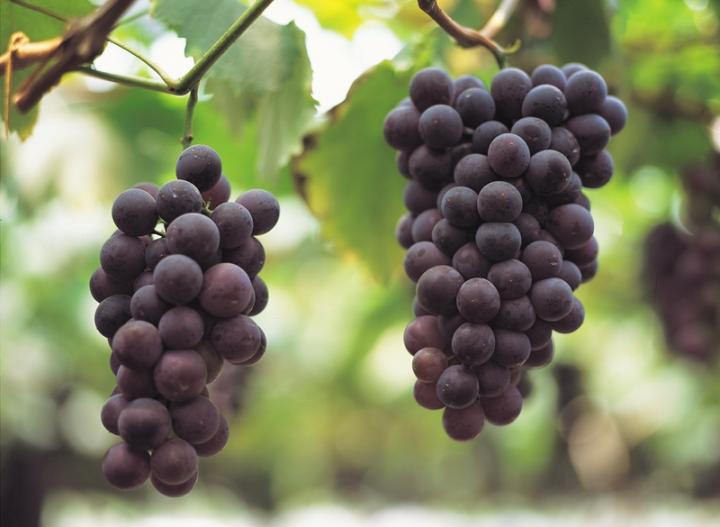
Grapes, a long season crop, are often ignored in home gardens, and yet are one of the most widely produced fruits in the world. We have plenty of tips for growing grapes in your own backyard.
Grapevines not only produce sweet and versatile fruits, they add an element of drama to a garden or landscape. They are vigorous growers, and with the proper pruning, they will produce fruit with ease and can last longer than 30 years.
There are three different types of grapes: American (V. labrusca), European (V. viniferia), and North American native Muscadine (V. rotundifolia). American grapes are the most cold-hardy, while European grapes, usually more for wine than the table, do well in warm, dry, Mediterranean type zones. Hybrids are available. Thick skinned Muscadines thrive in the South.
Make sure you purchase grape vines from a reputable nursery. Vigorous, 1-year-old plants are best. Smaller, sometimes weaker, 1-year-old plants are often held over by the nursery to grow another year and are then sold as 2-year-old stock. Obtain certified virus-free stock when possible.
Planting
- Plant dormant, bare-root grape vines in the early spring.
- Construct a trellis or arbor before planting. Grape vines will need to be trained to some sort of support to grow upward. This will also cut the risk of disease.
- Most grape varieties are self-fertile. To be sure, ask when you are buying vines if you will need more than one plant to for pollination.
- Before planting grapevines, soak their roots in water for two or three hours.
- Select a site with full sun. If you don’t have a spot with full sun, make sure it at least gets morning sun. A small amount of afternoon shade won’t hurt. Your soil needs to be deep, well-drained, and loose. You also need good air circulation.
- Space vines 6 to 10 feet apart (16 feet for muscadines).
- For each vine, dig a planting hole 12 inches deep and 12 inches wide. Fill with 4 inches of topsoil. Trim off broken roots and set the vine into the hole slightly deeper than it grew in the nursery. Cover the roots with 6 inches of soil and tamp down. Fill with the remaining soil, but don’t tamp this down.
- Prune the top back to two or three buds at planting time.
- Water at time of planting.
Care
- In the first couple of years, the vine should not be allowed to produce fruit. It needs to strengthen its root system before it can support the extra weight of fruit.
- Pruning is important. Not only would vines run rampant without control, but canes will only produce fruit once. Prune annually when vines are dormant, in March or April. This is before the buds start to swell, but when winter damage is apparent.
- Don’t be afraid to remove at least 90 percent of the previous season’s growth. This will ensure a higher quality product. Remember, the more you prune, the more grapes you will have.
- In the first year, cut back all buds except for 2 or 3. Then, select a couple of strong canes and cut back the rest. Make sure the remaining canes are fastened to the support.
- In the second year, prune back all canes. Leave a couple of buds on each of the arms. Remove flower clusters as they form.
- Do not fertilize in the first year unless you have problem soil. Fertilize lightly in the second year of growth.
- Use mulch to keep an even amount of moisture around the vines.
- A mesh net is useful in keeping birds away from budding fruit.
Pests/Diseases
- Aphids
- Japanese Beetles
- Powdery Mildew
- Black Rot
Harvest/Storage
- If grapes aren’t ripening, pinch back some of the foliage to let in more sunlight.
- Grapes will not continue ripening once picked from the vine. Test a few to see if they are too your liking before harvesting, usually in late summer-early fall.
- Grapes are ripe and ready to harvest when they are rich in color, juicy, full-flavored, easily crushed but not shriveled, and plump. They should be tightly attached to the stems. Check our ripeness guide for more tips on color.
- Grapes can be stored for up to six weeks in the cellar, but grapes can absorb the odors of other fruits and vegetables, so keep them separate. Use cardboard boxes or crates lined with clean, dry straw. Separate bunches with straw or sawdust. Check often for spoilage.
- See our article on Making Jams and Jellies.
Recommended Varieties
Note: Seedless varieties will produce smaller grapes.
- ‘Edelweiss’ Hardy, early white variety. Table and wine.
- ‘Reliance’ Hardy, seedless, pink table grape.
- ‘Seibel’ Hybrid, wine grape. Cold hardy.
- ‘Swenson Red’ Cold hardy red table grape.
- ‘Magnolia’ White Muscadine wine grape. Sweet.
- ‘Valiant’ Eating grape hardy to Zone 2.
Wit & Wisdom
Grapefruit (Citrus paradisi) resemble grapes only in that they grow in clusters, but that was sufficient reason for early European explorers in Barbados to bestow this name on them.
Recipes
- Grape Jelly
- Grape Salad
- Grape Catsup






